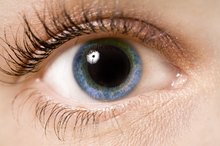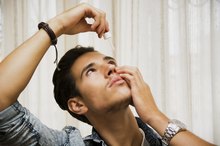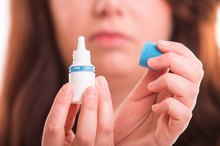Adverse Reaction to Pupil-Dilating Eye Drops
The pupil is the central opening in the iris, the colored part of the eye. Pupil size modulates the amount of light entering the eye. In lighted conditions, the pupil opening is normally relatively small.
If you are experiencing serious medical symptoms, seek emergency treatment immediately.
Pupil-dilating drops temporarily override normal control of the pupil size, causing it to open widely.
Dilating drops are most often used during an eye examination to enable the doctor to fully examine the interior lining of the eye.
**Dilating drops are also used before or after some eye procedures and to treat certain eye conditions.
** Different medications are used to dilate the pupils.
Like all medications, pupil-dilating drops can cause adverse reactions. Most are mild and temporary.
Stinging Sensation
All pupil-dilating drops sting when put into the eye. This sensation normally lasts only for a few seconds, but might cause tearing and rapid blinking.
Anesthetic eye drops are sometimes used to numb the eye before instilling the pupil-dilating drops. This eliminates the stinging sensation and is particularly useful for children.
- All pupil-dilating drops sting when put into the eye.
- Anesthetic eye drops are sometimes used to numb the eye before instilling the pupil-dilating drops.
Blurred Vision and Light Sensitivity
Side Effects of Steroid Eye Drops
Learn More
**Blurred vision -- especially near vision -- is an expected side effect with several commonly used drops used to dilate the pupils.
Vision blurs until these drops wear off because they interfere with an eye reflex, called accommodation, that enables the eye to focus between near and far objects.
** All dilating eye drops cause temporary sensitivity to light, since the pupil is not able to constrict to limit light entry into the eye. Wearing sunglasses until the drops wear off reduces discomfort and protects the eyes.
- Blurred vision -- especially near vision -- is an expected side effect with several commonly used drops used to dilate the pupils.
- Vision blurs until these drops wear off because they interfere with an eye reflex, called accommodation, that enables the eye to focus between near and far objects.
Allergic Reaction
Allergic reactions to eye drops are generally uncommon and most often seen with drops used on a long-term basis.
Allergic reactions to pupil-dilating drops are rare, but possible.
An allergic reaction to eye drops can be due to the medicine or the preservative.
Eye and eyelid redness, swelling of the eyelids and itchiness are possible symptoms. Alert your eye doctor if you've had a reaction to eye drops in the past, even if the reaction was not caused by pupil-dilating drops.
- Allergic reactions to eye drops are generally uncommon and most often seen with drops used on a long-term basis.
Acute Angle-Closure Glaucoma
Alphabetic List of Eye Drops for Glaucoma
Learn More
Acute angle-closure glaucoma is a very rare, but serious adverse effect that can be triggered by pupil-dilating drops. Clear fluid, called the aqueous humor, circulates through the front chamber of the eye. The amount of fluid remains constant as fluid is produced and drained at an equivalent rate.
Glaucoma is a group of eye diseases characterized by increased internal eye pressure due to buildup of aqueous humor. The increased pressure can damage the eye nerves, potentially causing vision loss.
Dilating drops can trigger a form of glaucoma called acute angle-closure glaucoma, characterized by an abrupt increase in eye pressure due to obstructed outflow of the aqueous humor -- known medically as closure of the anterior chamber angle 7. According to a January 2006 "BMJ" review article, the risk of acute angle-closure glaucoma due to dilating drops is significantly less than 1 percent 7. Symptoms of acute angle-closure glaucoma include: -- aching eye pain and eye redness -- headache -- halos around lights and blurry vision -- persistently dilated pupil -- nausea and vomitin 7g
- Acute angle-closure glaucoma is a very rare, but serious adverse effect that can be triggered by pupil-dilating drops.
- Dilating drops can trigger a form of glaucoma called acute angle-closure glaucoma, characterized by an abrupt increase in eye pressure due to obstructed outflow of the aqueous humor -- known medically as closure of the anterior chamber angle 7g
Effects Beyond the Eyes
The medication in pupil-dilating drops can be absorbed into the bloodstream and lead to adverse effects beyond the eyes, known as systemic side effects. These side effects are rare, and most commonly occur in infants and young children.
The specific systemic effects depend on the medication or medications in the dilating drops, and more frequently occur with drops that have a prolonged duration of action. Possible systemic side effects include: -- dry mouth -- facial flushing -- increased blood pressure and/or heart rate -- irritability or confusion -- fever -- headache
- The medication in pupil-dilating drops can be absorbed into the bloodstream and lead to adverse effects beyond the eyes, known as systemic side effects.
Cautionary Notes
The effects of drops used to dilate the eyes for an examination typically subside completely within 6 to 24 hours, depending on what drops were used and how much medicine was put into the eyes. If you have any symptoms after this period, contact your doctor. Seek emergency care if you develop symptoms of acute angle-closure glaucoma to prevent permanent vision loss 7.
Reviewed and revised by: Tina M. St. John, M.D.
- The effects of drops used to dilate the eyes for an examination typically subside completely within 6 to 24 hours, depending on what drops were used and how much medicine was put into the eyes.
Related Articles
References
- GlobalRPh: Ophthalmic -- Mydriatics and Cycloplegics
- Ophthalmic Medications and Pharmacology, 2nd Edition; Brian Duvall and Robert M. Kershner
- Clinical Ocular Pharmacology, 2nd Edition; Jimmy D. Bartlett and Siret D. Jaanus
- Current Opinion in Allergy and Clinical Immunology: Allergic Reaction to Topical Eyedrops
- DailyMed: Tropicamide Solution/ Drops
- BMJ: Fundoscopy: To Dilate or Not to Dilate?
- American Academy of Ophthalmology: Angle-Closure Glaucoma
- American Academy of Ophthalmology. Can you use contact lens rewetting drops to moisten your bare eye? Updated April 23, 2019.
- American Academy of Ophthalmology. Redness-Relieving Eye Drops. Updated August 31, 2018.
- Centers for Disease Control and Prevention. Other Complications. Updated March 21, 2016.
Writer Bio
A registered nurse with more than 25 years of experience in oncology, labor/delivery, neonatal intensive care, infertility and ophthalmology, Sharon Perkins has also coauthored and edited numerous health books for the Wiley "Dummies" series. Perkins also has extensive experience working in home health with medically fragile pediatric patients.









